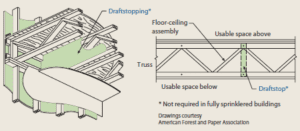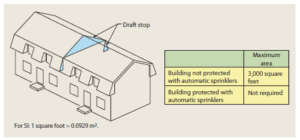Sprinkler Advantages for Draftstopping

Concealed spaces in combustible construction are one of the bigger opportunities for fire growth in a building. Experience has shown that some of the greatest damage occurs to conventional wood framed building during a fire when the fire travels unimpeded through concealed draft openings. This often occurs before the fire department has an opportunity to control the fire, and greater damage is created as result of the lack of fire blocking. For these reasons, the code requires fireblocking and draftstopping to prevent the spread of fire through concealed combustible draft passageways. Virtually any concealed air space within a building will provide an open channel through which high-temperature air and gases will spread. Fire and hot gases will spread through concealed spaces between joists, between studs, within furred spaces, and through any other hidden channel that is not fireblocked. However, we are going to focus on draftstopping.
The International Building Code (IBC) has many requirements for draftstopping. Draftstops are often used to subdivide large concealed spaces within floor/ceiling assemblies of combustible construction. Gypsum board, wood structural panels, particleboard, mineral wool, or glass fiber batts and blankets, and other approved materials are considered satisfactory for the purpose of subdividing floor/ceiling areas, provided the materials are of adequate thickness, are adequately supported, and their integrity is maintained. Draftstops are to be installed in floor/ceiling assemblies in residential occupancies. The code requires that draftstops be installed in line with the fire partitions separating tenants or dwelling units from each other and the remainder of the building as the diagrams below shows. This is where the first advantage comes into play. Where a residential occupancy is sprinklered, this draftstopping is not required. However, where a residential sprinkler system is used, automatic sprinklers must also be installed in the combustibles concealed floor areas in order to eliminate the draftstops.

Photo courtesy of the ICC
 Photo courtesy of Woodworks
Photo courtesy of Woodworks
Additionally, in all occupancies other than residential, the code intends that the concealed space within the floor/ceiling assembly be separated by draftstopping so that areas of any concealed space does not exceed 1,000 square feet. This where the second advantage can be applied. There is an exception in this section that permits the elimination of draftstopping where automatic fire sprinklers are installed throughout the building.
In attics and concealed roof spaces of combustible construction, the code requires draftstopping under certain circumstances. The materials used for this draftstopping is consistent to those required in floors. In residential occupancies, draftstops are to be installed above and in line with the walls separating dwellings units or between walls separating sleeping units. There some exceptions that apply and installing a sprinkler system is one of those exceptions and our next advantage. . In other occupancies draftstops are required by the IBC to be installed in attics and similar concealed roof spaces for buildings, so that the area between draftstops does not exceed 3,000 square feet. This is the final sprinkler advantage.

Photo courtesy of the ICC
Using these sprinkler trade offs is a major advantage in the design phase. These trade offs can provide a major cost savings in the overall construction project. Especially when you compile them with many additional sprinkler trade offs which can be found in the, “NFSA Sprinkler Guide: 2018 International Building Code Edition.” We will continue discussing these trade offs in detail in future blogs.
